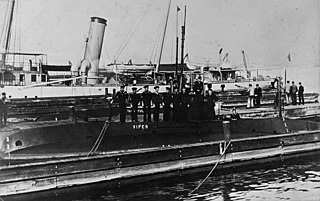The Ship/Submarine Recycling Program (SRP) is the process that the United States Navy uses to dispose of decommissioned nuclear vessels. SRP takes place only at the Puget Sound Naval Shipyard (PSNS) in Bremerton, Washington, but the preparations can begin elsewhere.
General Dynamics Electric Boat (GDEB) is a subsidiary of General Dynamics Corporation. It has been the primary builder of submarines for the United States Navy for more than 100 years. The company's main facilities are a shipyard in Groton, Connecticut, a hull-fabrication and outfitting facility in Quonset Point, Rhode Island, and a design and engineering facility in New London, Connecticut.

USS Holland (SS-1) was the United States Navy's first modern commissioned submarine, although not the first military submarine of the United States, which was the 1775 submersible Turtle. The boat was originally laid down as Holland VI at the Crescent Shipyard of Elizabeth, New Jersey for John Philip Holland's Holland Torpedo Boat Company, and launched on 17 May 1897. She was acquired by the USN on 11 April 1900 and commissioned on 12 October 1900, Lieutenant H. H. Caldwell commanding.

USS Dallas (SSN-700) is a Los Angeles-class nuclear-powered attack submarine of the United States Navy. She was the Navy's second vessel of that name, and the first to be named after the city of Dallas, Texas, although another two ships were scheduled but never completed. On 4 April 2018, after nearly 37 years of commissioned service, the boat was decommissioned at the Controlled Industrial Area of Puget Sound Naval Shipyard. The defueled vessel will eventually undergo recycling.

USS Simon Lake (AS-33) was the lead ship of her class of submarine tenders in the United States Navy, named for Simon Lake, a pioneering designer of early submarines.

USS Sunfish (SSN-649), a Sturgeon-class attack submarine, was the second ship of the United States Navy to be named for the ocean sunfish, a marine species having a deep body truncated behind, and high dorsal and anal fins.

USS Flying Fish (SSN-673), a Sturgeon-class attack submarine, was the third ship of the United States Navy to be named for the flying fish, any of number of fishes whose long winglike fins make it possible for them to move some distance through the air.

USS Springfield (SSN-761), a Los Angeles-class submarine, is the fourth ship of the United States Navy to bear the name. The boat was named in honor of both the cities of Springfield, Illinois and Springfield, Massachusetts.

USS Jacksonville (SSN-699), a nuclear powered Los Angeles-class attack submarine, is the only vessel of the United States Navy to be named for Jacksonville, Florida.

Fore River Shipyard was a shipyard owned by General Dynamics Corporation located on Weymouth Fore River in Braintree and Quincy, Massachusetts. It began operations in 1883 in Braintree, and moved to its final location on Quincy Point in 1901. In 1913, it was purchased by Bethlehem Steel, and later transferred to Bethlehem Shipbuilding Corporation. It was sold to General Dynamics in 1963, and closed in 1986. During its operation, yardworkers constructed hundreds of ships, for both military and civilian clients.

USS B-1 (SS-10) was the lead ship of her class of submarines built for the United States Navy in the first decade of the 20th century.

USS Emory S. Land (AS-39) is a United States Navy submarine tender and the lead ship of her class. She was named for Admiral Emory S. Land.

Frank Taylor Cable was an early pioneer in submarine development and piloted the first United States Navy submarine, USS Holland during its pre-commissioning trials.

USS Frank Cable (AS-40) is the second Emory S. Land-class submarine tender built by the Lockheed Shipbuilding and Construction Company of Seattle, Washington for the United States Navy.
Arthur Leopold Busch or Du Busc was a British-born American naval architect responsible for the development of the United States Navy's first submarines.

USS Fulton (AS-11) was the leader of her class of seven submarine tenders, launched on 27 December 1940 by Mare Island Navy Yard and sponsored by Mrs. A. T. Sutcliffe, great-granddaughter of Robert Fulton. Fulton was commissioned on 12 September 1941.

USS Dixon (AS-37) was an L. Y. Spear-class submarine tender, in service to the United States Navy from 1971 through 1995. Dixon was named for George E. Dixon, commander of the Confederate submarine H. L. Hunley.
Lawrence York Spear was an American naval officer and businessman who spent the majority of his career working for the Electric Boat Company.

USS Minnesota (SSN-783) is a nuclear powered fast attack submarine, the 10th of the planned 30-boat Virginia-class. She is the third United States Navy vessel to bear the name and the second of two named for the state, while the other was named for the Minnesota River.















